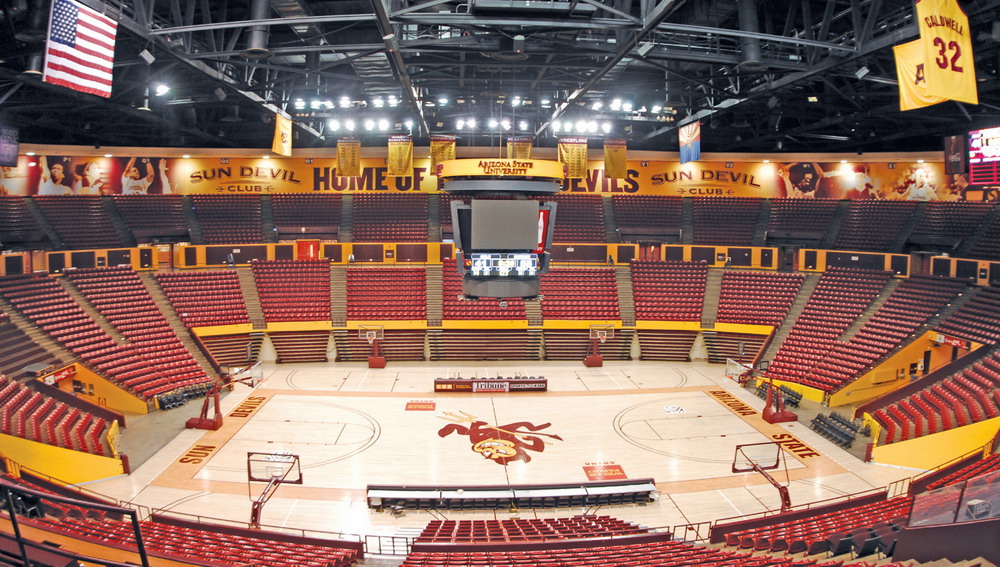This is the first edition of our new column, Vinyl Apps. Each month, ST will delve into a unique, printed-graphic application, with some explanation from the fabricating shop about its design, production and installation process. If you have an application you’d like to submit for consideration, please contact Sr. Associate Editor Steve Aust at steve.aust@stmediagroup.com or (800) 925-1110, ext. 308.
For several years, Tempe-based bluemedia has fabricated numerous types of printed graphics for Arizona State University (ASU), also in Tempe. From banners to vehicle graphics to stadium-wall wraps, bluemedia has thoroughly branded ASU’s campus and athletic facilities with Sparky, ASU’s pitchfork-wielding mascot, and its signature, maroon-and-gold color scheme.
Wells Fargo Arena has served as the on-campus home for ASU teams since 1974, and school officials chose to update the facility last year with fiery wall graphics. The school enlisted Blind Society, a Scottsdale, AZ-based firm that specializes in unconventional advertising and marketing campaigns, to design a “branding wall” on the arena’s upper level. Bluemedia has served as Blind Society’s preferred print provider for five years.
Eric Rutin, bluemedia’s director of sales and marketing, said. “One of the tasks was to make sure that whatever application we produced could be taken down within a short amount of time to comply with building permits and possible delays that permanent structures would require.”
After having considered several ideas, ASU’s representatives and the institution’s marketing-rights holder, IMG College, ordered an approximately 1,000-linear-ft. (roughly 15,000 sq. ft.) wrap that features images of Sun Devil basketball players, gymnasts and wrestlers. The ASU athletic depart¬ment furnished the base graphic elements as both raster and vector art, and Blind Society perfected the artwork as .tiff files using Adobe Photoshop. Darren Wilson, Blind Society’s co-founder, said “We use the full [Adobe] Creative Suite for most projects, but when using both types of artwork, Photoshop works most efficiently.”
While surveying the arena, blue¬media considered the project with regard to potential fire-safety concerns. Rutin said, “It was impos¬sible to avoid blocking a few of the rows of seats and the aisles, so we had to make sure whatever solution we produced would conform to all University safety standards.”
Advertisement
To permit access to the two catwalk-access doors, bluemedia constructed pass-throughs to allow workers an entryway. Rutin added, “We think this is the finest pipe-and-drape system in the industry. It’s provides both the support strength and portability these types of jobs require.”
Bluemedia produced the project using 6-oz., triple-weave, dye-subli¬mation fabric due to its excellent color retention, lightweight construc¬tion, flexibility and fire-retardant properties. Rutin continued, “The graphics had to appear as if they were integral to the wall itself. So, we chose dye sublimation media because material used for this type of printing has an ability to stretch tightly when used with a sturdy frame. If we’d used, traditional, PVC-based material, it would have been too heavy and rigid.”
Bluemedia developed color proofs using its Epson proofing machine, and printed the graphics using the shop’s Scitex XL Jet 3 piezo inkjet printer. The project required 18, 52-ft.-long, 14.5-ft.-wide panels. The framing systems’ vertical posts dictated the distance. Wilson said, “Normally, we let our RIP soft¬ware create tiles. But, in this case, we created tiles in the design phase and sent them to press separately.”
To install the project, bluemedia took advantage of some extra labor. When the shop moved into larger quarters last fall, the utility company required the company to shut down for six hours while it installed a new meter system. Bluemedia scheduled the meter set-up for a Monday morning, and, to take advantage of available labor, Jared Smith, the shop’s president, dispatched all 63 staff members to the arena at 4 a.m. to install the graphics. Obviously, installation progressed quickly.
Installers wrapped panels, poles, temporary walls and custom stands that made the end poles of inter¬secting sections abut one another to eliminate the appearance of seams.
The use of temporary walls instead of permanent structures eased regula¬tory requirements. The city’s fire marshal and the university’s risk-management director provided the only required approvals.
Advertisement
“The biggest challenge of the project was making text that extended from one panel to the next seamlessly,” Rutin said. “Because the design was so busy, the graphic elements flowed more easily from one panel to the next, but the letters required precise, deliberate alignment.”



 Tip Sheet3 days ago
Tip Sheet3 days ago
 Business Management2 weeks ago
Business Management2 weeks ago
 Women in Signs2 weeks ago
Women in Signs2 weeks ago
 Real Deal4 days ago
Real Deal4 days ago
 Editor's Note1 week ago
Editor's Note1 week ago
 Benchmarks12 hours ago
Benchmarks12 hours ago
 Line Time2 weeks ago
Line Time2 weeks ago
 Product Buying + Technology1 week ago
Product Buying + Technology1 week ago







